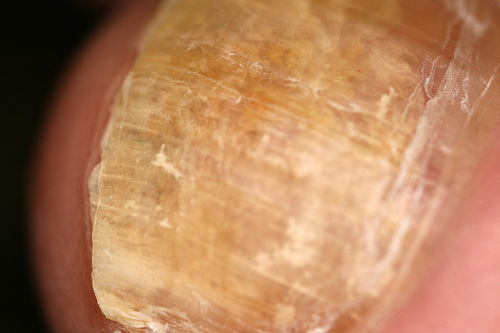
Sometimes just using a topical nail fungus treatment isn’t quite enough. Nail fungus is a difficult condition to treat – even if you do break down, go to the doctor, and get high-powered prescription medications – and you need to try multiple approaches to find something that will work. The problem is that the fungus gets down underneath the nail, and the nail’s primary job is to protect the soft tissue underneath from the outside world. Unfortunately, this means it protects the fungus from the healing powers of just about everything that you try to throw at it.

If you want to get rid of your nail fungus, you are going to have to stay dedicated to the task and try as many different remedies as you can. Don’t give up too soon on something, though. It can take months to see any improvement in nail fungus, even with doctor prescribed treatments. With home remedies, you have to use the treatments consistently and loyally, even when it seems like it won’t work. Of course, your best course of action is to prevent nail fungus from the start.
Tips for Using Topical Nail Fungus Treatments
If you have a topical nail treatment for your nail fungus, you are ahead of the game, but you can do a few things to make that treatment even more effective than merely rubbing it on your nail and leaving it alone. Topical nail treatments need to penetrate the hard, brittle nail that the fungus has created. Unfortunately, nail is not absorbent, so if you have thick nails, that topical solution is just sitting on top of the nail and not attacking the fungus. For starters, keep your nails clean and dry at all times. Fungus and bacteria in general love a warm, wet environment. If you have sweaty feet, use an anti-fungal foot powder to keep your feet dry.

- 1. Don’t use nail polish because this only acts as an additional barrier for the topical treatment to penetrate.
- 2. File your nails down and rough up the surface of the nail with a nail file to allow the treatment to penetrate down to the tissue.
- 3. In extreme circumstances, you can have the nail removed entirely so that the medication can kill off the fungal infection. The toenail will grow back after eight to ten months. Permanent toenail removal is not often recommended for fungal infections unless they are causing a great deal of pain.
How to Prevent Nail Fungus Infections
If you do get your nail fungus under control, you want to prevent further infections. In fact, you want to prevent spreading the infection to your other nails because you will have even more difficulty getting rid of the infection if it spreads. For instance, pay attention to the spaces between your toes. They can often harbor bacteria and lead to the fungal infection spreading from one toe to the next. Keep your socks and shoes clean, as well. You should change your socks at least one per day, but change them more if you have sweaty feet. Your shoes should be well-ventilated and fit your feet well. Too tight and they can lead to moisture and more fungus growing.
Always trim your nails straight across to prevent them from pushing against footwear. This can cause trauma and an entrance pathway for the fungus. File down thickened parts of the nail to keep them clean and dry. If your hands are exposed to water frequently – such as a dishwasher – wear rubber gloves to protect your nails from fungus. People who bite their nails or pick at the skin around their nails are more prone to a fungal infection because the teeth can open up an infection pathway and the mouth introduces bacteria into the wound.
Always wear shoes in public showers or other places where bacteria may be present on the floor, and give up the artificial nails that trap bacteria beneath the nails. If you must get a manicure, be sure to go to only a reputable salon that takes proper hygienic measures. Most importantly, wash your hands immediately after working with your infected nail. Do not touch your other nails after cutting, treating, or otherwise dealing with the infected nail. Wash your hands, and then move on to care for the other nails.
Simple Home Remedies to Treat Nail Fungus Infections
You can do a great deal of different soaks, solutions, and topical applications of home remedies to help heal your nail fungus infection. One of the most common home remedies that can be used in conjunction with other treatments is the use of vinegar. You can soak your feet in a vinegar solution that is one part vinegar to two parts water. You should keep your feet soaking for at least 15 to 20 minutes to allow the solution to penetrate the nails and tissue more thoroughly. Another variation on this soak is to use apple cider vinegar. Experts suggest a 50/50 lukewarm water to apple cider vinegar bath. Again, soak for 15 minutes. You can also apply vinegar directly to the toe two to three times per day. No matter how you use vinegar, make sure you wash and dry your feet thoroughly when you are done with your soak. Any moisture that is left behind is a breeding ground for the fungus and will have the opposite effect you are looking for.
Another popular soak is to use mouthwash to help kill off some of the fungus under your nail. Wash your feet first by taking a bath, then pour antiseptic mouthwash into a basin and soak your nails in it for 30 minutes. You will need to wash your feet or hands with soap and water after your soak, and make sure to dry well, too. Disinfect the basin that you use for your soaks to prevent the fungus from growing in it between soakings. You could end up reinfecting yourself or possibly infecting other nails.
Vick’s VapoRub is another home remedy that is often used to fight nail fungus. Experts recommend creating grooves in the infected nail with a nail file to aid absorption. You simply put a glob of the VapoRub on the nail bed and let it absorb. This treatment can be used a few times a day for several days, but different references have different instructions for the VapoRub remedy. You might have to try several techniques to find something that works.
You can find several outlandish treatments for nail fungus out there, but they are worth mentioning if they help. You can make a solution that is one part pine cleaner and one part soy sauce. Using a dropper, apply this to the affected nail after washing your feet or hands. Another possible treatment is garlic. One remedy calls for sleeping with garlic cloves in the ends of your socks or using a garlic paste to apply it directly to the nail. Whatever you find to help with you nail fungus, if you start to feel pain, irritation, or redness, stop using the treatment and contact your doctor. If you cannot get any relief from your nail fungus situation and it is becoming painful, you may need to see your doctor for more definitive treatment that may include prescription medication.
Click Here For Highest Rated Nail Fungus Treatments
1. Funginix - www.Funginix.com
2. Zetaclear - www.Zetaclear.com
3. PurNail - www.Purnail.com

Bill Zhang says:
The talk of laser treatments and sunlight/magnifying glass treatments brings to mind another device that is similar in that it uses RF frequency energy to radiate RF energy subcutaneously. It was invented over 100 years ago by Nikola Tesla and is called a “Violet Ray”. It was sold on the open market until the early 50s when the FDA outlawed it’s use because people were making outrageous claims for what it could and couldn’t do. Despite the fact it was effective for specific things they simply prohibited it’s use for anything. That’s government for you. However it remained legal outside the US and no disasters seem to have occurred. At worst it didn’t work for some ailments, perhaps in part because it was used improperly. However almost identical versions of the device are still made in the US for use by medical professionals, particularly dermatologists where it is used to remove warts, freckles and other skin discolorations. I have several antique devices and several of the devices made in England. (Using antique devices is risky as the electrical design is primitive and potentially dangerous). I have not used it for toenail fungus but in theory it should work as it is sort of an RF (radio frequency energy) variation on what lasers or even magnifying glasses do with penetrating irradiation that can disable if not outright kill living cells. I have used it on skin discolorations with some beneficial effect. Has anybody tried it on toenail fungus? Would be very interested in the result.
Bil says:
Thank you for sharing. The violet ray was not invented by Tesla. He invented the Tesla Coil and the VR uses a similar coil. Also it was not banned in the US. In 1950 some of the VR manufacturers were sued by the FDA for false advertising. Also during WW2 some of the companies made coils for military 2-way radios instead since they had the equipment. These devices are FDA approved for use on the face and scalp. Widely sold at Amazon. etc; under the name “High Frequency” machine. But they are not near as powerful as the antique models – used ones widely available at Ebay – must be rewired and the capacitor replaced with a MPP type. Powerful new models also available but advertised for industrial use. One is made by Electro Technic. Same model sold at baar.com as a violet ray.